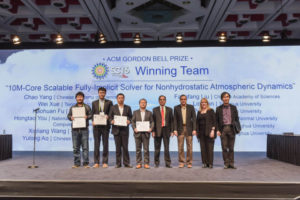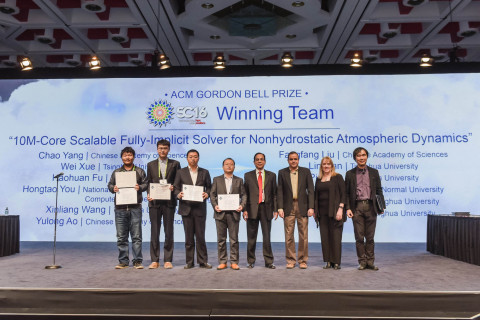 A weather research team from China has won 2016 ACM Gordon Bell Prize for their research project, “10M-Core Scalable Fully-Implicit Solver for Nonhydrostatic Atmospheric Dynamics.” The winning team presented a method for calculating atmospheric dynamics on the world’s fastest computer, the 93 Petaflop Sunway TaihuLight system.
A weather research team from China has won 2016 ACM Gordon Bell Prize for their research project, “10M-Core Scalable Fully-Implicit Solver for Nonhydrostatic Atmospheric Dynamics.” The winning team presented a method for calculating atmospheric dynamics on the world’s fastest computer, the 93 Petaflop Sunway TaihuLight system.
The ACM Gordon Bell Prize tracks the progress of parallel computing and rewards innovation in applying high performance computing to challenges in science, engineering, and large-scale data analytics. The award was bestowed during SC16 in Salt Lake City.
“On the road to the seamless weather-climate prediction, a major obstacle is the difficulty of dealing with various spatial and temporal scales. The atmosphere contains time-dependent multi-scale dynamics that support a variety of wave motions.”
Since the dawn of computing, scientists have used data analytics in an effort to predict and simulate the weather and related atmospheric events. In the early years of weather forecasting, scientists might have used standard CPUs. With each passing year, the continued expansion in the capabilities of high performance computers has enabled researchers to employ increasingly sophisticated computational methods for the analysis and modeling of weather patterns. Advanced scientific computers break problems down into composite parts and perform immense amounts of mathematical calculations simultaneously. The performance of a supercomputer is measured in floating-point operations per second (FLOPS). Some of the latest supercomputers are capable of performing quadrillions of FLOPS.
In the abstract of their presentation, the winning team writes, “On the road to the seamless weather-climate prediction, a major obstacle is the difficulty of dealing with various spatial and temporal scales. The atmosphere contains time-dependent multi-scale dynamics that support a variety of wave motions.”
To simulate the vast number of variables inherent in a weather system developing in the atmosphere, the winning group presents a highly scalable fully implicit solver for three-dimensional nonhydrostatic atmospheric simulations governed by fully compressible Euler equations. Euler equations are a set of equations frequently used to understand fluid dynamics (liquids and gasses in motion).
Elaborating further, they add, “In the solver, we propose a highly efficient domain-decomposed multigrid preconditioner that can greatly accelerate the convergence rate at the extreme scale. For solving the overlapped subdomain problems, a geometry-based pipelined incomplete LU factorization method is designed to further exploit the on-chip fine-grained concurrency.”
The fully-implicit solver successfully scales to the entire system of the Sunway TaihuLight, a Chinese supercomputer with over 10.5 M heterogeneous cores, allowing for a performance of 7.95 PFLOPS in double precision. The Chinese team contends that this is the largest fully-implicit simulation to date. The Sunway TaihuLight is ranked as the fastest supercomputer in the world. It is nearly three times as fast as the Tianhe-2, the supercomputer that previously held the world record for speed.
Winning team members include Chao Yang, Chinese Academy of Sciences; Wei Xue, Tsinghua University; Haohuan Fu, Tsinghua University; Hongtao You, National Research Center of Parallel Computer Engineering and Technology; Xinliang Wang, Beijing Normal University; Yulong Ao, Chinese Academy of Sciences; Fangfang Liu, Chinese Academy of Sciences, Lin Gan, Tsinghua University; Ping Xu, Tsinghua University; Lanning Wang, Beijing Normal University; Guangwen Yang, Tsinghua University; and Weimin Zheng, Tsinghua University.
Innovations from advanced scientific computing have a far-reaching impact in many areas of science and society—from understanding the evolution of the universe and other challenges in astronomy, to complex geological phenomena, to nuclear energy research, to economic forecasting, to developing new pharmaceuticals. The annual SC conference brings together scientists, engineers and researchers from around the world for an outstanding week of technical papers, timely research posters, and tutorials.




